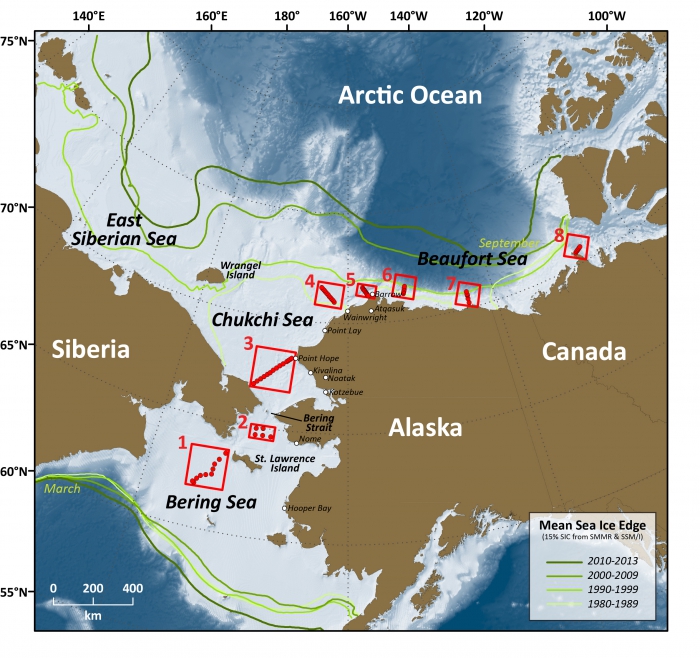By: Sue E. Moore, National Oceanic and Atmospheric Administration (NOAA)/Fisheries ST7 and Jacqueline M. Grebmeier, University of Maryland, Center for Environmental Science (UMCES)
The IARPC Distributed Biological Observatory (DBO) Collaboration Team, led by Sue Moore (NOAA) and Jacqueline Grebmeier (UMCES), has completed a decadal DBO Implementation Plan. The Plan focuses on the period 2015 - 2024 and provides a framework for the preparation of Periodic Assessments of the State of Pacific Arctic Marine Environment (PARMA) at three-year intervals starting in 2018. The PARMA will be based on analyses and modeling using DBO-generated data and data from projects supported by the National Oceanic and Atmospheric Administration (NOAA), National Science Foundation (NSF), Bureau of Ocean Energy Management (BOEM), National Aeronautics and Space Administration (NASA), North Pacific Research Board (NPRB), and other sources. Internationally, linkages to pan-Arctic DBO-type sampling programs will be fostered, including transects identified by the Arctic Council CAFF/Circumpolar Biodiversity Monitoring Program and the Protection of the Arctic Marine Environment (PAME)/Implementation of Ecosystem Approach (EA) to Management Program. Regionally, the DBO Implementation Plan identifies specific strategies to foster connections with existing community-based observation programs in an effort to link offshore observations of biological change to local observations and Indigenous knowledge.
Other achievements in 2016 include the completion of year-seven of sampling in DBO/Chukchi regions 1-5, and opportunistic sampling in DBO/Beaufort regions 6-8 in the Pacific Arctic sector (see Figure 1). Field-sampling was contributed by colleagues from 11 projects representing 5 countries. Since 2010, the DBO has provided a framework to focus and coordinate sampling and analytical efforts that link biological changes to physical drivers in a rapidly changing Arctic. A key science achievement of this framework has been the ability to track shifts in benthic community biomass and structure concomitant with measures of annual sea ice persistence in five DBO regions1,2,3,4. An important physical oceanographic achievement, through occupation of the DBO-5 (Barrow Canyon) line, has been the observation of the seasonal freshening and warming of sea water transiting northward on the eastern and surface layers of the Chukchi Sea, with the maximum temperature observed in Septembersup5.
Internationally, the DBO continues to benefit from organizational support from the Pacific Arctic Group (PAG), including integrated collaborations with the Pacific Arctic Climate Ecosystem Observatory (PACEO). These achievements in international cooperation lay the groundwork for a truly pan-Arctic biological observatory, as envisioned at the PAME EA International Conference.

References
1Grebmeier, J.M., and L.W. Cooper 2016. The Saint Lawrence Island Polynya: A 25-year Evaluation of an Analogue for Climate Change in Polar Regions, pp. in: Glibert, P.M, and T.M. Kana (eds.), Aquatic Nutrient Biogeochemistry and Microbial Ecology: A Dual Perspective. Springer International Publishing, Switzerland.
2Grebmeier, J.M., B.A. Bluhm,, L.W. Cooper, S.L. Danielson, K.R. Arrigo + 12 co-authors. 2015. Ecosystem characteristics and processes facilitating persistent macrobenthic biomass hotspots and associated benthivory in the Pacific Arctic. Progress in Oceanography 136: 92-114.
3Grebmeier, J.M., B.A. Bluhm, L.W. Cooper, S.G. Denisenko, K. Iken, M. Kedra, and C. Serratos. 2015. Time-series benthic community composition and biomass and associated environmental characteristics in the Chukchi Sea during the RUSALCA 2004~2012 program. Oceanography 28(3): 3):116-133, http://dx.doi.org/10.5670/oceanog.2015.61
4Nishino, S., T. Kikuchi, A. Fujiwara, T. Hirawake, 2016. Water mass characteristics and their temporal changes in a biological hotspot in the southern Chukchi Sea. Biogeosciences, 13, 2563-2578; doi:10.5194/bg-13-2563-2016
5Itoh, M., R.S. Pickart, T. Kikuchi, Y. Fukamachi, K.I. Ohshima + 8 co-authors. 2015. Water properties, heat and volume fluxes of Pacific water in Barrow Canyon during summer 2010. Deep-Sea Research I 102: 43-54.
